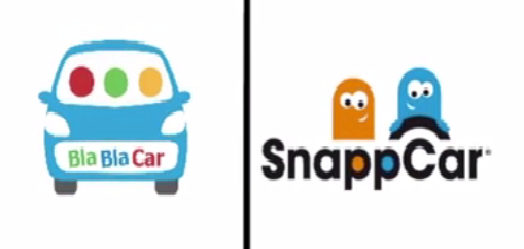In our TOTW project we looked at thetransformation of the transportation industry. Specifically how BlaBlaCar and SnappCar help thousands of strangers to find a convenient and comparably cheap way of getting from A to B. We have shortly summarized basic company facts in the table beneath the video:
http://https://www.youtube.com/watch?v=w0C61dE7ckE&feature=youtu.be
|
BlaBlaCar |
SnappCar |
|
| Participants | > 20 Mio (worldwide) (Bloomberg, 2015) | 200,000 in DN,NL,S (Wharton, 2016) |
| Total estimated value of platform | $1.6 billion (Bloomberg, 2015) | $6.28 MIO |
| Charges to participants | Fixed fee: 0.99€ (NL)
Variable fee: 11,90% of fare (NL) BTW |
Fee: at least 8.75€ (NL) |
| Acquisitions (so far) | 5 | 1 |
BlaBlaCar and SnappCar are leading and still growing players in the transportation industry. But they could never have gotten this far without help, which is why we also introduced Cindy, Kate and Tom. (you have not met them yet? Here you go: https://www.youtube.com/watch?v=w0C61dE7ckE&feature=youtu.be). Cindy was looking for a ride to Maastricht while Tom offered a seat in his car for the desired trip and Kate offered her entire car. SnappCar and BlaBlaCar both provided a possible platform for these three strangers to meet.
The questions we answer in our video are: Platform-mediated networks: What are they? How do they make money? How do they compete?
The basic idea behind both platforms is as old as time: it is trade! “You have something I need or would like to have, while I have something you need or would like to have.” In our example, some users offer an entire car or seats in their car, while passengers are looking for a means of transport. BlaBlaCar and SnappCar provide the platform for both sides of users to meet. Why do they do it? Because there is money to be made! Over time, the platform providers have proceeded to charging fees to one side of the users. BlaBlarCar adds a booking fee on the fare price (BlaBlaCar, 2016), while SnappCar charges at least a basic fee (SnappCar, 2016), which is not always greeted by the users (Die Zeit, 2016), but how do you decide which platform you use?
This question is answered by the network effect! BlaBlaCar has millions of users worldwide-tendency rising; SnappCar’s reputation in its operating countries has been immensely growing since its inception. Clearly, you will choose the platform where you are most likely to find what you are looking for! The more drivers/car owners, the more passengers on the other side and vice versa, the cross side effect! The goal and decisive competing factor for either platform is to continuously concentrate as many users on as possible on their own platform. If they manage to win the race against their competitors, the Winner-takes-it-all!
But what will the future look like, both BlaBlaCar and SnappCar somehow do a similar thing; could they not merge to one platform? Possibly! Our chosen platforms do not competing head-to-head (yet) but they have strong complementary features. We believe that it is likely that one player will take over the other and integrates the complementary functionality in the future; this would be envelopment (Eisenmann, Parker, Van Alstyne, 2006). As competiton in the ride-sharing sector is rising, we strongly believe that these firms will look do anything to get into the winning position. What do you think? Watch the video and feel free to discuss!
Group 49: S. Buunk(459362), J. Dahm (460607), S. Legtenberg (461533), C. Osterholz(459302)
Sources:
BlaBlaCar (2016), https://www.blablacar.nl/faq/vraag/hoe-worden-de-reserveringskosten-berekend-en-wat-dekken-ze last accessed 25.09.2016
Bloomberg (2015), www.bloomberg.com/…/blablacar–value-hits-1-6-billion-after-latest-funding-round Last accessed 29.09.2016
Die Zeit (2016) http://www.zeit.de/mobilitaet/2016-08/blablacar-gebuehren-mitfahrgelegenheiten-kosten, last accessed 25.09.2016
Eisenmann, T., Parker, G., and Van Alstyne, M.W. 2006. Strategies for Two-Sided Markets. Harvard Business Review 84(10) 92-101.
SnappCar (2016), https://support.snappcar.nl/hc/nl/articles/203671771-Hoeveel-kost-huren-via-SnappCar-Last accessed 29.09.2016
Wharton – University of Pennsylvania (2016), http://knowledge.wharton.upenn.edu/article/peerby-snappcar-europes-sharing-economy-driven-efficiency/ last accessed 29.09.2016

